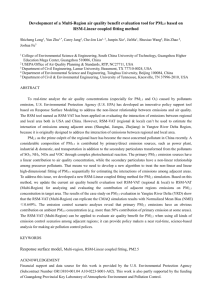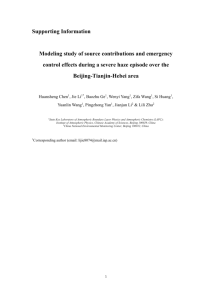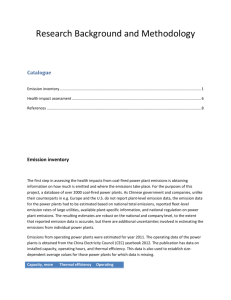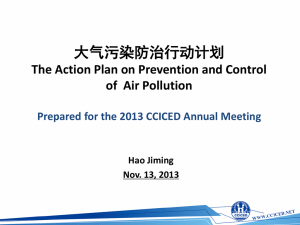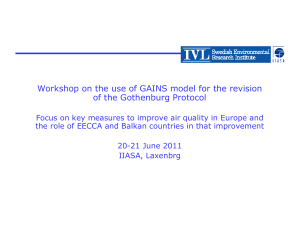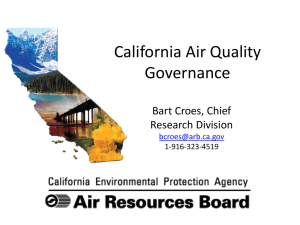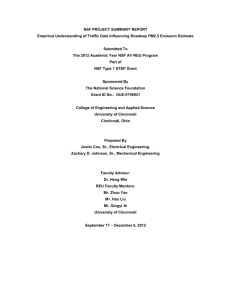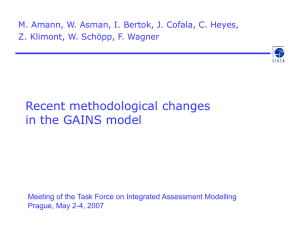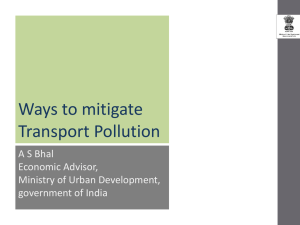Slide 1 - rksi.org
advertisement
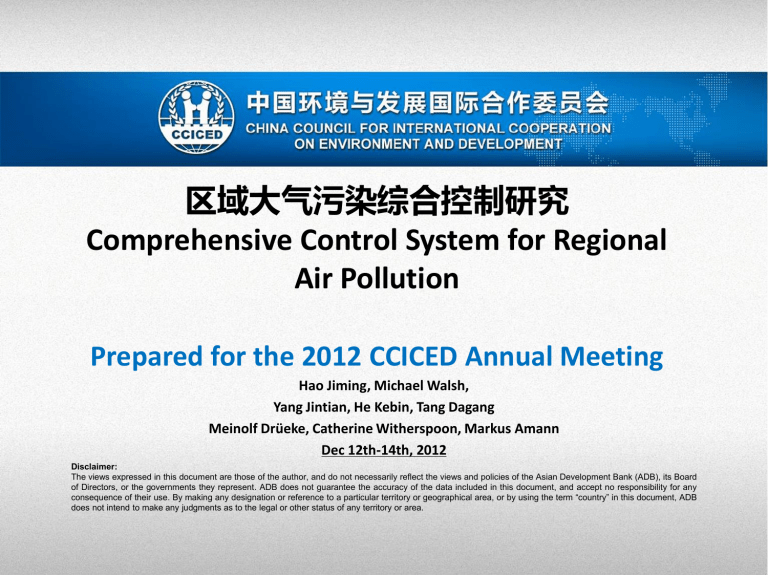
区域大气污染综合控制研究 Comprehensive Control System for Regional Air Pollution Prepared for the 2012 CCICED Annual Meeting Hao Jiming, Michael Walsh, Yang Jintian, He Kebin, Tang Dagang Meinolf Drüeke, Catherine Witherspoon, Markus Amann Dec 12th-14th, 2012 Disclaimer: The views expressed in this document are those of the author, and do not necessarily reflect the views and policies of the Asian Development Bank (ADB), its Board of Directors, or the governments they represent. ADB does not guarantee the accuracy of the data included in this document, and accept no responsibility for any consequence of their use. By making any designation or reference to a particular territory or geographical area, or by using the term “country” in this document, ADB does not intend to make any judgments as to the legal or other status of any territory or area. 纲要 Outline • 中国区域大气污染特征 Characteristics of regional air pollution in China • 当前控制措施与未来挑战 Current efforts and challenges • 政策建议 Policy recommendations 全球PM2.5以及O3浓度最高的区域 Highest PM2.5 and O3 concentration in the world 全球PM2.5浓度分布 Global PM2.5 concentration 全球O3浓度分布 Global O3 concentration 上海市PM2.5和O3同时超标率的比例 Ratio of days when both O3 and PM2.5 don’t comply in Shanghai 中国PM2.5 /PM10比例逐年增加 Rising PM2.5 /PM10 ratio in China 北京PM2.5/PM10比值的变化趋势 Trends of PM2.5/PM10 ratio observed in Beijing 中国的PM2.5/PM10 比值( 60-70%)相对发达国家 (50%) 较高,这表明: Higher PM2.5/PM10 Ratio in China (60-70%) than in developed countries indicates: 1. 对人体健康有更大影响 Larger health impact 2. PM控制面临更大的困难 More difficulties in PM control 控制区域污染是解决局地污染的关键之一 Control of regional contribution is critical to local attainment 北京PM2.5排放源解析结果 上海PM2.5排放源解析结果 * 依据北京&上海环保局发布数据整理 Based on Beijing & Shanghai EPB data • 20~25%来自于区域传输(绿色) 20~25% from regional transport (green) 区域性污染物排放是PM2.5中二次颗粒物形成的重要贡献 Regional emissions play important roles in forming Secondary PM2.5 Local SO2 Local NOx Regional NH3 Regional SO2 Regional NOx 2.0 2.0 0.4 0.2 1.6 - 0.6 1.6 1.2 - 0.0 1.0 1.2 NO3 response 0.8 NO3 response 2- SO4 response 1.0 0.8 0.8 0.6 0.4 0.2 Beijing: SO4 0.6 0.4 0.2 0.0 Beijing: NO32.2 0.4 1.8 0.0 1.0 0.8 0.6 1.4 1.0 0.4 0.2 0.0 0.6 Emission ratio 0.2 0.0 1.0 0.8 Emission ratio - 0.4 0.4 2- NO3 response 0.6 0.8 0.0 1.0 0.0 1.0 0.8 1.2 Emission ratio 2- • 区域NOX排放贡献了北 京和上海硝酸盐的50% Regional NOX is responsible for 50% of nitrate in Beijing and Shanghai 1.2 SO4 response • 区域SO2排放贡献了北 京硫酸盐的80%, 上海 的40% Regional SO2 is responsible for 80% of sulfate in Beijing, and 40% of sulfate in Shanghai Local NH3 0.2 0.8 0.6 0.4 0.2 Emission ratio Shanghai: SO4 0.0 1.0 0.8 0.6 0.4 0.2 0.0 Emission ratio 2- Shanghai: NO3- Response of SO42- and NO3- concentration from local & regional emission control 二次颗粒物为中国东部地区PM2.5中的主要组分 Secondary PM2.5 dominant in Eastern China •硫酸盐+硝酸盐+氨盐(SNA,绿)几乎 占PM2.5化学物种构成的一半 Sulfate + Nitrate + Ammonia (SNA, green bar) contribute to half of PM2.5 污染物来源广泛,成分复杂 Contributed by multi-pollutants, multiple sources 固定源 Stationary point sources 移动源 Mobile sources 地区源 Area sources (Power plants, industrial sources, etc.) (On-road & off-road) (Commercial, residential, natural) PM SO2 PM2.5 公共健康 Public Health NH3 NOx Acid rain O3 能见度 Visibility VOC 气候 Climate 生态系统 Eco-system 纲要 Outline • 中国区域大气污染特征 Characteristics of regional air pollution in China • 当前控制措施与未来挑战 Current efforts and challenges • 政策建议 Policy recommendations 单位GDP排放量降低,但总排放量升高 Emission intensity declined, but total emissions increased 单位GDP排放量 Emissions per unit GDP 总排放量 Total emissions SNA含量持续增长 SNA kept growing 北京PM2.5的化学组成 Chemical components of PM2.5 in Beijing • 硫酸盐+硝酸盐+氨盐(SNA)在过去十年中呈增长趋势 Sulfate + Nitrate + Ammonia (SNA, red plots for Summer) increased in last decade • S:夏季;W:冬季 S: stands for Summer, W: stands for Winter 机动车排放得到控制,但仍面临挑战 Emissions from vehicles controlled, but challenge still large 1999-2000,制定了严格的机动车&燃料控制政策,但贯彻实施不足 1999-2010, very strong control program on vehicles & fuels, but the program has stalled 至“十一五”末期: By the end of the 11th-five year plan: 机动车数量增加250% Vehicle population increased by 250% ; 机动车排放量仅上升1.6%-11.9% Vehicle emissions increased only by 1.6%-11.9% 注: 1. 不包括摩托车;exclude motorcycles; 2. 不同污染物的排放增长量有所差异;Emissions depending on different pollutants 机动车排放得到控制,但仍面临挑战 Emissions from vehicles controlled, but challenge still large 机动车数量急剧增加:2020年将会达到 2.1-2.4亿辆,2030年增至4.1-5.3亿辆! Fast increase of vehicle population: will reach 210-240 million units in 2020, and 410-530 million units in 2030! 机动车排放得到控制,但仍面临挑战 Emissions from vehicles controlled, but challenge still large 未来20年间客运以及货运交通都将有巨大增量 Very Rapid Growth is Forecast for both passenger and freight traffic over the next two decades! 不同地区客运交通增量预测 (与2000年相比) 不同地区货运交通增量预测 (与2000年相比) 机动车排放得到控制,但仍面临挑战 Emissions from vehicles controlled, but challenge still large 高硫份柴油阻碍了更严格机动车排放标准的实施 High sulfur diesel fuel discouraged enforcement of more stringent emission standards 2500 Plan 2000 1500 1000 500 0 实际的硫含量在500至700ppm之间 Actual fuel sulfur contents between 500 to 700 ppm 油品质量问题两次延误重型柴油车标准的实施 Twice delayed the truck standards because the fuel quality Actual 机动车排放得到控制,但仍面临挑战 Emissions from vehicles controlled, but challenge still large 非道路移动源排放 Off-road VOCs加油排放 Refueling VOCs 0.20 0.15 (g/km) Em ission Rate 0.20 0.10 0.11 0.10 0.07 0.05 0.00 机动车加油过程排放的VOCs高于国IV和国V标准的尾气排放 Refueling emission is higher than Euro IV & V tailpipe emissions 需要加强对非道路移动源(船舶、飞机等)排放的重视 Off-roads need to be considered: vessel, aircraft and etc. 区域联防联控机制已建立,立法有待完善 Joint control mechanism explored, but law is inadequate 北方地区六省 6 provinces in Northern China 长三角地区三省 YRD, 3 provinces 珠江三角洲地区九市 PRD,9 cities 在全国范围内建立长期的区域 间合作机制,需要法规、管理 机制、以及机构等多方面的支 持及保障。 Law, regulations, and institutional support is necessary for long-term regional cooperation in the whole country 新的环境空气质量标准带来了新挑战 New challenges brought by the new air quality standards 2010年中国333个城市的PM10年均浓度 Annual average concentration of PM10 in 333 Chinese cities in year 2010 2010年各城市PM2.5年均浓度 Annual average concentration of PM2.5 in year 2010 AAQS 2010年O3浓度超标的天数 Number of days when O3 concentration exceed AAQS in year 2010 Huizhou Guangzhou Qingdao Shenyang Chongqing Tianjin Shanghai Beijing 0 20 40 60 Days 80 100 北方城市Northern China 南方城市Southern China 控制目标难度很大,但是仍不足以实现全面达标 Roadmap for compliance is aggressive and difficult, but is still not sufficient Emissions of primary PM and gaseous precursors Percentage of cities whose annual average PM2.5 concentration over 35ug/m3 100% 80% 60% 40% 20% 0% 2010 2012 2014 2016 2018 2020 2022 2024 “十二五” SO2和NOX减排目标分别是8%和10%。即使一次颗粒物和SO2、NOX 、 VOCs 、 NH3等污染物排放量在每个五年计划都下降15%,至2025年,仍有 超过20%的城市无法达到PM2.5的年均浓度标准。 More than 20% cities could NOT comply with the PM2.5 annual concentration standards in 2025 even if 15% emissions of primary PM and SO2, NOX, VOCs, and NH3 reduced in each Five Year Plans, which is much higher than current 8% and 10% reduction target in total emission control 纲要 Outline • 中国区域大气污染特征 Characteristics of regional air pollution in China • 当前控制措施与未来挑战 Current efforts and challenges • 政策建议 Policy recommendations 国际经验表明空气质量的改善需要持续实施措施并进行评估 International experience highlights a continuous cycle of development and improvement Establish Goals Determine Emission Reduction Targets 建立环境目标 确定减排目标 Scientific Research 科学研究 Control Strategies 控制措施 On-going Evaluation 跟踪评估 Implementation Programs 项目实施 大气污染防治法难以有效解决现存问题 Air Pollution Control Law is too weak to address current problem 1987 大气法颁布 APCL promulgated 1995 2000 2012 第一次修订 第二次修订 1st 2nd amendment amendment ??? 2000 2012 污染物 Pollutants SO2, PM10 PM10, PM2.5, O3 (及所有前体物, and all precursors) 地区 Area 城市 Urban 区域 Regional 主要来源 煤 Major contributors Coal 煤,移动源等 Coal, mobile sources, etc. 需要通过法律明确城市、区域和国家的大气污染防治责任 Law: responsibility of local, regional and national 政策建议1:强化法律责任 Recommendation 1: enhancing legal authorities 强化多污染物控制要求:危害人体健康的PM2.5以及O3及其前体物 To address multiple pollutants control: the control of PM2.5 and O3 that harm human health and their precursor pollutants 解决区域大气污染:明确规定地方以及国家政府的权利与责任,以及跨行政区传输 污染物的防治责任。 To address regional air pollution: Clearly define the responsibility and authorities of local as well as the national government for compliance, and establish responsibility for air pollution that reaches beyond each city’s jurisdictional boundaries 控制所有的主要污染源:授予环保部对于所有排放源的管辖权,包括对机动车燃料 以及船舶,火车,飞机等非道路移动源的管理。 To address all major emission sources: provide the MEP with the authority over all sources, including motor vehicle fuels and off-road vehicles such as vessels, locomotives and aircrafts 避免违法行为:强化对违法行为的处罚力度,提高违法成本。 To avoid violations (plural): increase the violation costs and penalties for violation practices 整合大气污染控制功能及职责 Integrated air pollution function needed to clarify responsibilities 环保部 MEP 规划财务司 Dept. of Planning & Finance 规划&预算 Planning & budget management 政策法规司 Dept. of Policies, Laws & Regulations 建立健全法律法规 Legislating and rules making 科技标准司 Dept. of Science, Technology & Standards 空气质量及排放标准 Air quality and emissions standards 污染物排放总量控制司 Dept. of Total Pollutants Control SO2以及NOx的控制计划 Emission control programs for SO2 and NOX 环境监测司 Dept. of Environmental Monitoring 建立空气质量的监测网络 Management of air quality monitoring network 污染防治司 Dept. of Pollution Prevention & Control 促进及监管大气污染防治措施的实施 Promoting and overseeing air pollution control 提高大气质量需要更多的资源投入 More resources needed for improving air quality 美国环保署在大气质量方面的工作人员数量 Number of US EPA employees working on air quality 华盛顿办公室 10个区域办公室 Headquarters 10 Regions 工作人员 Staff 524 科技人员 S&T* Staff 362 550 *Science and Technology 为达到大气质量定量化和精细化的管理要求,我国需要全面整合更 多的资源 Substantially greater resources needed to support quantified and specified air quality management 美国环保署:~1400人 US EPA: ~1400 personnel 中国环保部:数十人 MEP: dozens personnel 政策建议2:优化组织结构,提高管理能力 Recommendation 2: institutional arrangements 环保部:全面整合相关职责及资源,建立专门的大气管理机构来统一 协调大气环境管理工作,大力增加技术以及人力的支持 MEP: comprehensively integrate associated functions and resources, and set up a dedicated atmospheric management department for overall coordination, substantially increased technical support and human resources 区域性机构:在京津冀,长三角,珠三角等污染严重的典型地区,完 善相应的区域联防联控机制,建立专门机构统筹区域内管理工作 Regional institution: set up specialized agencies in areas with serious air pollution such as the BTH ,YRD and PRD to take charge for the overall regional air quality management, and develop accordingly regional mechanism. 其他措施:增加资金投入,开展和实施“国家清洁空气行动计划” Other capacity building: Increase the overall budget, promote “National Clean Air Action Program” 重工业的快速发展带来巨大的环境压力 Fast development of heavy industry brings huge burden 中国重工业的发展以及能源消耗 Develop of heavy industry and energy consumption in China 2000 2010 2010/2000 % of global in 2010 粗钢产量(百万吨) Steel (million ton) 129 627 4.86 44% 水泥产量(百万吨) Cement (million ton) 597 1868 3.13 60% 发电量(10亿千瓦时) Power generation (TWh) 1347 4193 3.11 20% 煤炭消费量(百万吨) Coal consumption (million ton) 1411 3122 2.21 48% 政策建议3:转变发展方式 Recommendation 3: change developing mode 宏观经济结构:建立可持续的投资及消费模式,走向低碳发展,减少 经济发展对于重化工业的依赖 Macroeconomic structure: towards low carbon economy by promoting sustainable investment and consumption patterns, reducing dependence on the heavy industries for economic development 工业生产:加快落后产能淘汰力度,提高准入门槛,促进清洁生产 Industrial producers: accelerate the phase-out of the outdated production capacity of heavy industries, increasing the technical barriers to market entry for new producers, and promote cleaner production. 产业布局:逐步疏散区域复合性污染严重地区(京津冀,长三角,珠 三角等)的重化工业产能 Industrial layout: gradually relocate the heavy industrial production capacity away from regions with severe complex air pollution problems (BTH, YRD, PRD, etc.) 政策建议4:清洁、高效和可持续利用煤炭 Recommendation 4: Control pollutions from coal use 能源结构:增加清洁能源在我国能源结构中的比重,力争每五年使煤炭在我 国一次能源中的比重降低3-5% Energy structure: increase the proportion of clean energy such that share of coal is reduced by 3-5% in each FYP 终端设备:将煤炭使用向配有先进的燃煤污染控制技术的设备倾斜 End-use facility: shift coal consumption to facilities with state of the art pollution controls 布局:控制区域煤炭消耗总量 Layout: set regional caps on coal consumption 煤质:推进煤炭洗选和分级使用 Coal quality: promote coal washing, dressing and labeling 民用燃煤:减少民用部门的原煤燃烧,促进可再生能源、天然气和型煤使用 Residential use: reduce the use of raw coal for residential heating and cooking, promoting the use of renewable energy, natural gas or briquettes as alternatives. 末端污染控制:使用最佳可行技术,保证稳定运行 End-of-pipe control: BACT and stable operation 政策建议5:全面强化移动源污染控制 Recommendation 5: Stronger control of mobile sources & fuels 低硫燃料:推进道路以及非道路移动源汽柴油的低硫化 Low sulfur fuel: accelerate the introduction of near zero sulfur diesel (10 ppm) fuel for vehicles as well as off-road sources 更严格的车辆排放标准:尽早实施与清洁能源相配套的排放标准 Tighter New Vehicle Standards: move rapidly to state of the art controls as soon as clean fuels available 从燃料全生命周期控制VOC排放:推进新排放标准的实施,在加强尾气 VOCs及挥发排放的同时,加强加油过程的排放控制 VOC control from whole fuel system: promote new standards that requires state of the art control technologies on tailpipe and evaporative emissions as well as refueling emissions (which remain un-regulated in most regions) 交通体系:促进公共交通,优化交通管理 Transportation system: promote public transportation and optimize the traffic management 非道路排放:加快排放标准及政策的制定,尤其是船舶及港口排放控制 Off-road emissions: accelerate the introduction of emission standards, fuel standards and regulations, especially for vessels and ports

